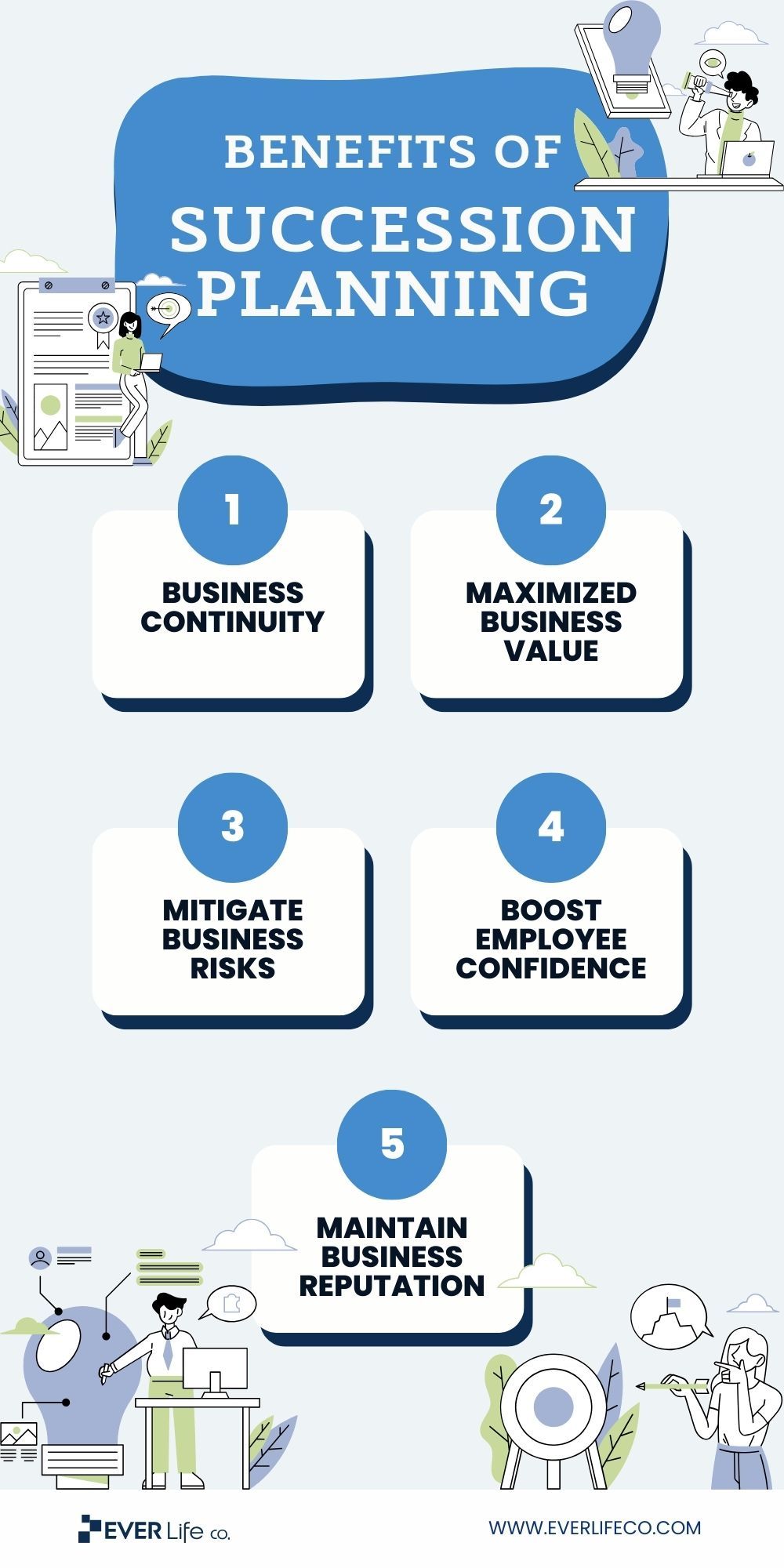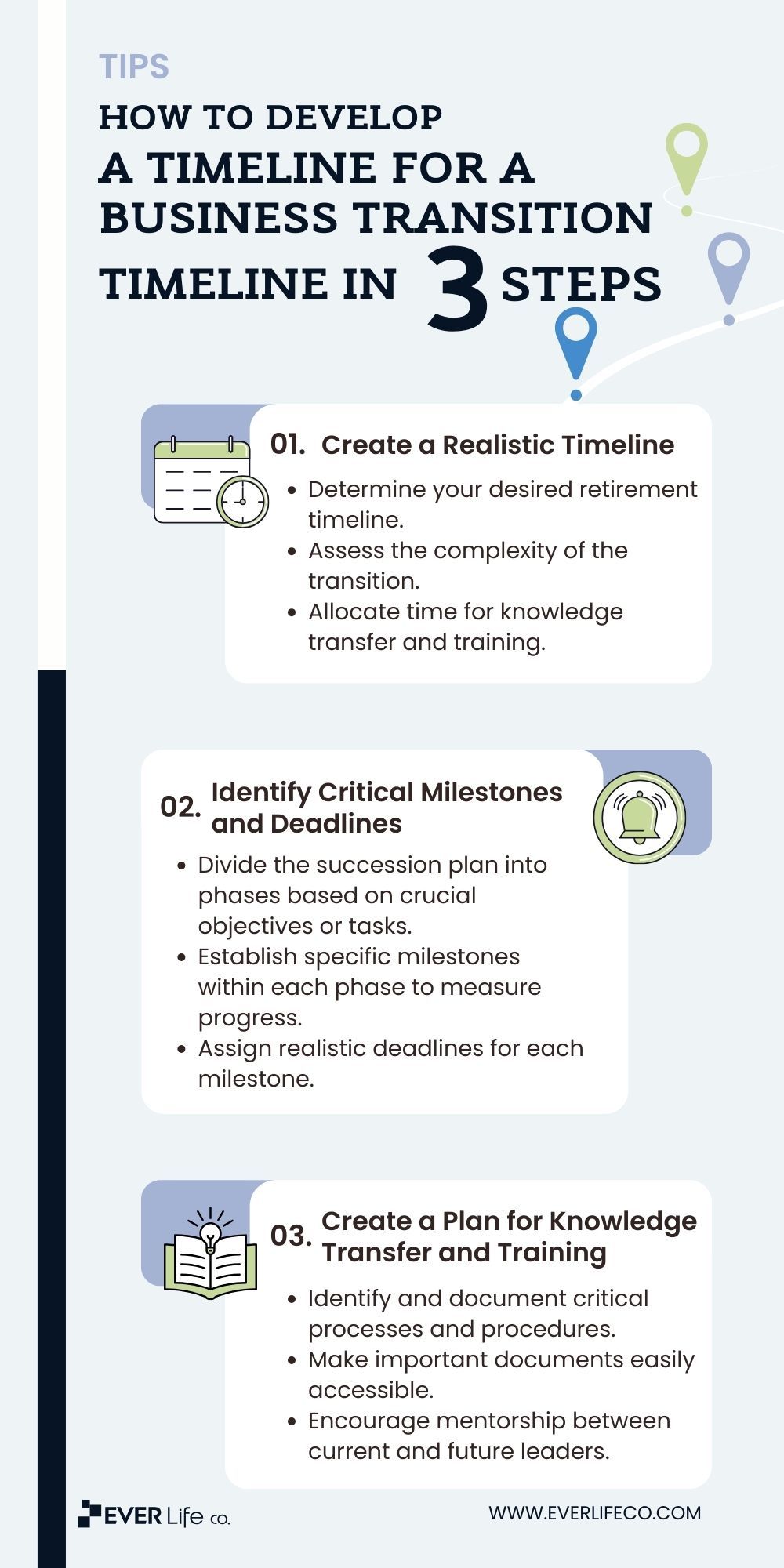As a small business owner, you’ve poured your heart and soul into building your enterprise. But have you considered what will happen to your business when you’re no longer at the helm?
In this two-part blog series, we’ll discuss the importance of having a succession plan and guide you through creating a comprehensive plan that ensures your business’s continuity and long-term success.
Part 1 Topics
- Understanding Business Succession Planning
- Assessing Your Business and Personal Goals
- Identifying Potential Successors
- Developing a Transition Timeline
- Addressing Legal and Financial Considerations
- Communicating the Succession Plan
- Implementing the Succession Plan
- Ensuring Business Continuity
- Reviewing and Updating the Succession Plan
Understanding Business Succession Planning
What is Business Succession Planning?
Succession planning is a strategic process that involves creating a comprehensive framework for the transfer of ownership and leadership of your company to a chosen successor(s) in the future. It's a proactive approach that allows you, as a small business owner, to carefully navigate the transition process and ensure your company's continuity and long-term success.
Benefits of Succession Planning
A well-crafted succession plan goes beyond transferring assets or managerial responsibilities. It encompasses various elements such as:
- Continuity: The primary goal of a succession plan is to ensure that your business continues to thrive and operate smoothly even after you step down. Identifying and preparing successors in advance minimizes disruption and maintains stability during the transition period.
- Maximizing Value: A well-executed succession plan helps maximize the value of your business. It involves assessing your company’s market value, identifying growth and improvement areas, and strategically positioning the business to attract potential buyers or groom successors who can further enhance its value.
- Mitigating Risks: Succession planning addresses the risks associated with unexpected events that may impact your ability to run the business. Whether it’s due to retirement, disability, or an unfortunate circumstance, having a plan in place ensures a smooth transition, minimizes uncertainties, and protects the interests of your stakeholders.
- Employee Confidence: A solid succession plan boosts employee confidence and loyalty. It assures your workforce that the future of the business is secure and that their roles and contributions will continue to be valued and recognized under new leadership. This assurance, in turn, fosters stability, productivity, and commitment within the organization.
- Business Reputation: With a clear roadmap for the transfer of power, you can safeguard the value, reputation, and legacy you’ve built over the years.

Common Challenges Faced During Succession Planning
While business succession planning offers numerous benefits, it has its challenges. Small business owners often encounter various obstacles that can make the process complex and overwhelming.
Awareness of these challenges lends to a proactive approach to addressing them and navigating the succession planning process with minimal negative impact.
Here are some common challenges faced during succession planning:
Emotional Attachments
For many business owners, their business is not a mere asset but a deeply personal endeavor. Letting go and transitioning to new leadership can be emotionally challenging.
Owners may struggle with feelings of uncertainty, loss of identity, or concerns about the future of their legacy. Overcoming these emotional attachments and approaching succession planning with objectivity and a long-term perspective is crucial.
Identifying the Right Successor
Selecting the right person or group of individuals to succeed you is a critical decision. It requires careful evaluation of their skills, experience, and ability to lead the business effectively.
Choosing among family members in family-owned businesses can be particularly difficult due to competing interests, differing abilities, or potential conflicts. Assess each potential successor objectively, evaluating their qualifications and alignment with the business’s vision and values.
Financial Considerations
Financial aspects play a significant role in succession planning. Valuing the business accurately, determining a fair transfer price, and addressing tax implications can be intricate processes. Lack of financial expertise or understanding of the complex legal and tax landscape can pose challenges.
Seeking guidance from qualified professionals such as accountants and lawyers experienced in succession planning will help you navigate these complexities and make informed decisions.
Lack of Time
Small business owners often have numerous responsibilities and limited time to dedicate to succession planning. Daily operational demands and managing day-to-day tasks can make it challenging to prioritize long-term planning.
However, delaying succession planning increases the risk of unexpected events derailing the business’s future. Making succession planning a priority and allocating dedicated time and resources is essential for successful implementation.
Communication and Buy-In
Succession planning involves multiple stakeholders, including family members, employees, investors, and other business partners. Ensuring open and transparent communication throughout the process reduces the stress and strain of the process.
Family dynamics, differing expectations, and concerns about the business’s future can lead to resistance or conflicts. Proactively engage stakeholders, address concerns, and foster a shared understanding of the succession plan’s benefits and objectives to obtain buy-in and support.
Knowledge Transfer and Training
The transfer of knowledge, skills, and relationships from the current owner to the successor(s) covers a significant portion of the transition process. Ensuring a smooth handover requires effective knowledge transfer and comprehensive training.
Identifying critical information, documenting processes, and providing mentorship opportunities are essential for preserving institutional knowledge and empowering the new leadership.
Only with careful planning, open communication, and a willingness to seek external expertise when needed can you address these challenges.
Assessing Your Business and Personal Goals
Evaluating Long-Term Business Objectives
To create an effective succession plan, evaluate your business’s long-term objectives. Reflect on the mission, vision, and core values of your company. Consider where you envision the company in the next five, ten, or twenty years. Are you aiming for growth, diversification, or geographic expansion?
Understanding your business’s aspirations will help shape the succession plan and ensure a friction-free transition aligned with your strategic goals.
Assess the market landscape and industry trends. Stay informed about emerging technologies, changing consumer preferences, and competitive forces. This analysis will enable you to identify potential challenges and opportunities that may impact the succession planning process and the future success of your business.
Identifying Personal and Family Goals
Beyond the business objectives, review your personal and family goals when developing a succession plan. Reflect on your aspirations, lifestyle choices, and long-term financial security. Do you envision a complete retirement or a reduced role in the organization? Are there specific personal or philanthropic endeavors you wish to pursue?
Moreover, involving your family in decision-making is vital, especially if you have a family-owned business. Seek input from family members regarding their interest and commitment to the company. Discuss their goals and aspirations to align them with the company’s future direction.
This collaborative approach ensures a frictionless transition and fosters family harmony and unity in the succession process.
Analyzing the Impact of Succession on Stakeholders
Successful succession planning goes beyond considering personal and business goals—it also accounts for the impact on various stakeholders.
Identify and understand key stakeholders’ expectations, concerns, and aspirations, such as employees, customers, suppliers, and investors.
Assessing Stakeholders
Employees: Evaluate the potential impact on your employees. Will there be changes in management or organizational structure? Communicate the succession plan transparently to build trust and alleviate concerns.
Address potential implications for job roles, career paths, and employee benefits to ensure an effortless transition for your workforce.
Customers and Suppliers:
- Evaluate how the succession plan may affect your relationships with customers and suppliers.
- Assure them of your commitment to maintaining quality products or services and uninterrupted supply chains.
- Introduce the new leadership to key stakeholders to foster continuity and confidence.
Investors and Shareholders: If your organization has investors or shareholders, assess their interests in the succession plan. Ensure the plan addresses their rights and expectations and communicates the procedure to maintain their confidence in the company.
Identifying Potential Successors
When creating a succession plan, carefully consider who will assume company ownership. While some entrepreneurs opt for a family member, like a child, to take over, others may choose a trusted business partner or key employee. Additionally, selling the business to an outside buyer is also a viable option to explore.
But how do you settle on whom to pass on your business to? Or decide if selling it is the best option?
Assessing Internal Candidates
Start your search in-house among the people you’ve trained and who know your organization best.
1 | Evaluate Key Employees
Look within your organization for potential successors. Identify key players who demonstrate strong leadership qualities, strategic thinking, and a deep understanding of business operations and company values.
Assess their track record, performance, and growth potential. Look for individuals who have shown commitment, initiative, and the ability to inspire and motivate others. These are the candidates you’ll further evaluate for future leadership positions.
While conducting this assessment of employee performance, you may uncover competency gaps. In this case, developing opportunities for additional training is a critical step that will boost employee engagement and your pool of talent for senior positions.
2 | Provide Development Opportunities
Invest in developing potential candidates by providing them with training, mentorship, and exposure to different areas of the company. Offer leadership programs, delegate important responsibilities, and encourage them to take on challenging assignments. These initiatives will enhance their current skills and test their readiness and adaptability.
An employee development plan will increase your company’s attractiveness to high-value hires seeking career advancement opportunities. Employee retention will also increase as your workers see room for growth within your organization.
3 | Consider a Leadership Team
Sometimes, the best approach may be to form a leadership team rather than a single successor. Creating a team allows for a collective approach to decision-making and brings together individuals with complementary skills and expertise.
Evaluate the dynamics within your organization to determine if a leadership team is a suitable succession option. It’s another career development opportunity that can attract high-value talents and boost employee morale.
Exploring External Candidates
Even if you’ve established an internal list of prospects, conduct an external search for candidates with values that align with your company.
1 | Networking and Industry Connections
Engage in networking activities and leverage industry connections to identify potential external candidates. Attend conferences, join professional associations, and participate in community events to expand your network.
Seek recommendations from trusted colleagues, mentors, or business advisors who may know individuals with the desired skillset and experience.
2 | Utilize Recruitment Resources
Consider partnering with executive search firms or recruitment agencies that specialize in identifying and evaluating candidates for leadership roles. These firms have extensive networks and expertise in matching candidates with specific skill requirements and cultural fit.
3 | Succession from Business Partners or Competitors
Explore the possibility of succession through partnerships or acquisitions. This option allows you to merge your business with another organization, integrating their leadership team into the succession plan.
Conduct thorough due diligence to ensure compatibility and alignment of values and goals before pursuing this path.
Family Succession
1 | Assessing Family Members
If you are considering passing the business to a family member, evaluate their qualifications, capabilities, career plans, and interest in accepting responsibility.
Consider their experience, skills, and willingness to learn and grow within the business. Objectively assess their suitability and if their aspirations align with the company’s long-term objectives.
2 | Facilitating Development
Offer family members opportunities for professional development and mentorship. Encourage them to gain experience outside the family business to broaden their perspectives and skill sets.
Implement a clear plan for their growth within the organization, ensuring they receive guidance and feedback along the way.
3 | Managing Family Dynamics
Family dynamics can present unique challenges in succession planning. Clearly define roles, responsibilities, and decision-making processes to mitigate conflicts and ensure a smooth transition. Establish open lines of communication, foster a culture of trust and transparency, and seek professional guidance if necessary to manage family dynamics effectively.
Keeping it in the Family
Selecting a suitable successor can be challenging, as it requires taking the best interests of everyone involved into account, including the business.
Keeping the business within the family is not always a viable option. Second-generation businesses have a high probability of failing. 70% of family-owned businesses either fail or are sold off before the second generation can succeed them. (Source)
These statistics aren’t a given. Success or failure depends on the FOB, the proper execution of a succession plan, and the new leadership. An objective evaluation of your options will put your company in the success story column.
If “going wide” with your company is the best solution, you can sell it and offer a monetary inheritance to your family members instead.
Developing a Transition Timeline
Creating a Realistic Timeline for the Succession Process
When developing a transition timeline for your succession plan, it is essential to consider various factors to ensure a smooth and successful transition.
Here are some fundamental concerns:
- Retirement Plans: Take into account your desired retirement timeline. Are you looking to completely step away from the business or gradually reduce your involvement over time? Understanding your retirement goals will help determine the overall timeline of the succession process.
- The Complexity of the Transition: Assess the complexity of the transition. Consider factors such as the size of your business, the number of stakeholders involved, and the intricacy of the operations. More complex transitions require additional time for planning, coordination, and implementation.
- Knowledge Transfer and Training: Allocate adequate time for knowledge transfer and training. Identify critical knowledge, processes, and procedures that you must document and transfer to the successor(s). Allow sufficient time for mentorship and knowledge-sharing between the current and future leaders.
Identifying Critical Milestones and Deadlines
Breaking down the succession plan into manageable phases and setting clear milestones and deadlines is essential for tracking progress and ensuring accountability.
- Define Phases: Divide the succession plan into phases based on key objectives or tasks. Typical phases may include identifying potential successors, preparing the successor(s), and executing the transition.
- Set Milestones: Within each phase, establish specific milestones that signify the completion of essential tasks or achievements. These milestones serve as markers of progress and help measure the overall success of the succession plan.
- Determine Deadlines: Assign realistic deadlines for each milestone to ensure the succession plan progresses according to the desired timeline. Deadlines provide a sense of urgency and help maintain momentum throughout the process.
Allowing Sufficient Time for Knowledge Transfer and Training
One of the critical aspects of a successful succession plan is the effective transfer of knowledge from the current owner to the successor(s). Here’s how you can ensure sufficient time for knowledge transfer and training:
- Document Critical Processes and Procedures: Identify the essential processes, procedures, and intellectual property you must transfer to the successor(s). Document them in a clear and accessible manner to ensure continuity and minimize disruptions.
- Facilitate Mentorship and Knowledge Sharing: Encourage mentorship and knowledge sharing between current and future leaders. This can involve job shadowing, regular meetings, and collaborative projects. Such opportunities allow the successor(s) to gain valuable insights and hands-on experience.
- Allocate Adequate Time: Recognize that knowledge transfer and training take time. Ensure that the timeline allows for a comprehensive transfer of knowledge and the development of necessary skills by the successor(s). Rushing this process may result in gaps in understanding and proficiency.
A well-planned timeline sets clear expectations, enables proper preparation, and increases the likelihood of a successful leadership transition within your business.

Conclusion
Crafting an effective succession plan is crucial for the longevity of your business and passing the torch to your successor(s). Understanding what’s expected with a business succession plan, assessing your goals, and identifying potential successors before outlining a timeframe is only the beginning.
Next, we’ll review the legal and financial considerations you need to know, how to effectively communicate and implement the plan to ensure business continuity, and the importance of reviewing and updating your plan.






